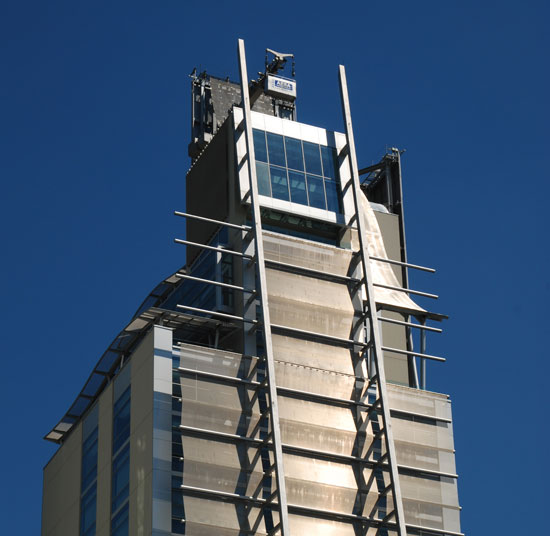A towering skyscraper in the central business district of Istanbul stands out as a striking example of Italian architectural design.
Text & images from Inossidable magazine Nr 225 by Centro Inox

The skyscraper housing the headquarters of the pharmaceutical company Abdi Ibrahim in the business area of Istanbul represents an important example of Italian architectural design (Figure 1). The 21,000 m2 tower extends below ground for five stories and rises 20 floors above ground to reach 120 meters at its highest point. Conceived as a single articulated structure, the building features external screens manufactured from micro-perforated stainless steel sheets that mask the emergency connections and utilities and, on the top, conceal the service equipment (for example, the machines for the air conditioning systems). The external panels create a compact and robust vision from the outside while also fulfilling the purpose of filtering the natural light that enters the building. This gives the building a constantly changing and transparent perspective when viewed from within while significantly contributing to the climatic comfort of the workplace.

At the level of the executive offices on the upper floors, the recessed internal spaces made it possible to create large open terraces protected by stainless steel mesh sails (Figure 2). On the southern side, an inclined tubular superstructure connects the lower portion of the tower with the upper section while supporting the external metal curtains.
A museum gallery area, meeting rooms and reception and waiting areas overlook the three-level entrance hall, the facade of which is distinguished by a huge glass painting. The stairs and connecting ramps appear to hang in the void, enhancing the illusion of them ‘breaking through’ the three-storey high space.
Stainless steel was used extensively for both the external and internal parts of the building. Externally the building features two significant stainless applications. These are the vertical screens made from EN 1.4401 (AISI 316) micro-perforated sheets; and stainless AISI 316 mesh curtains hanging from structural nodes running along the southern side of the building, connected to the inclined metal tubular structure (Figure 3).
The vertical shields are connected at regular intervals along the perimeter to a load-bearing structure composed of uprights and crosspieces that form square mesh frames that are hidden from view.


About Centro Inox
This article was provided by Centro Inox (through its magazine Inossidabile), a non-profit association involved in the study and development of stainless steel applications in Italy. For information visit www.centroinox.it/
Every week we share a new Featured Story with our Stainless Steel community. Join us and let’s share your Featured Story on Stainless Steel World online and in print.


